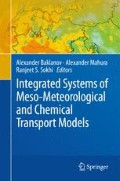Abstract
Tropospheric chemistry and air quality processes were implemented on-line in the Global Environmental Multiscale model. The integrated model, GEM-AQ, was developed as a platform to investigate chemical weather at scales from global to urban. The current chemical mechanism is comprised of 50 gas-phase species, 116 chemical and 19 photolysis reactions, and is complemented by a sectional aerosol module with 5 aerosols types. All tracers are advected using the semi-Lagrangian scheme native to GEM.
Access this chapter
Tax calculation will be finalised at checkout
Purchases are for personal use only
References
Benoit R, Cote J, Methot A (1989) Inclusion of a TKE boundary layer parametrization in the Canadian Regional Finite-Element Model. Mon Weather Rev 117:1726–1750
Cote J, Desmarais J-G, Gravel S, Methot A, Patoine A, Roch M, Staniforth A (1998a) The operational CMC–MRB Global Environmental Multiscale (GEM) Model. Part II: Results. Mon Weather Rev 126:1397–1418
Cote J, Gravel S, Methot A, Patoine A, Roch M, Staniforth A (1998b) The operational CMC–MRB Global Environmental Multiscale (GEM) Model. Part I: design considerations and formulation. Mon Weather Rev 126:1373–1395
Gong SL, Barrie LA, Blanchet J-P, von Salzen K, Lohmann U, Lesins G, Spacek L, Zhang LM, Girard E, Lin H, Leaitch R, Leighton H, Chylek P, Huang P (2003) Canadian Aerosol Module: a size-segregated simulation of atmospheric aerosol processes for climate and air quality models, 1. Module development. J Geophys Res 108:4007. doi:10.1029/2001JD002002
Gong SL, Huang P, Zhao TL, Sahsuvar L, Barrie LA, Kaminski JW, Li YF, Niu T (2007) GEM/POPs: a global 3-D dynamic model for semi-volatile persistent organic pollutants - 1. Model description and evaluations. Atmos Chem Phys Discuss 7:3397–3422
Grell GA, Peckham SE, Schmitz R, McKeen SA, Frost G, Skamarock WC, Eder B (2005) Fully coupled “online” chemistry within the WRF model. Atmos Environ 39:6957–6975
Hervig ME, Russell JM III, Gordley LL, Park JH, Drayson SR (1993) Observations of aerosol by the HALOE experiment onboard UARS: a preliminary validation. Geophys Res Lett 20:1291–1294
Huang P, Gong SL, Zhao TL, Neary L, Barrie LA (2007) GEM/POPs: a global 3-D dynamic model for semi-volatile persistent organic pollutants – Part 2: global transports and budgets of PCBs. Atmos Chem Phys Discuss 7:3837–3857
Jockel P, Tost H, Pozzer A, Bruhl C, Buchholz J, Ganzeveld L, Hoor P, Kerkweg A, Lawrence MG, Sander R, Steil B, Stiller G, Tanarhte M, Taraborrelli D, van Aardenne J, Lelieveld J (2006) The atmospheric chemistry general circulation model ECHAM5/MESSy1: consistent simulation of ozone from the surface to the mesosphere. Atmos Chem Phys 6:5067–5104
Kaminski JW, Plummer DA, Neary L, McConnell JC, Struzewska J, Lobocki L (2002) First application of MC2-AQ to multiscale air quality modelling over Europe. Phys Chem Earth 27:1517–1524
Kaminski JW, Neary L, Struzewska J, McConnell JC, Lupu A, Jarosz J, Toyota K, Gong SL, Côté J, Liu X, Chance K, Richter A (2008) GEM-AQ, an on-line global multiscale chemical weather modelling system: model description and evaluation of gas phase chemistry processes. Atmos Chem Phys 8:3255–3281. doi:10.5194/acp-8-3255-2008
Kuo HL (1974) Further studies on the parametrization of the influence of cumulus convection on largescale flow. J Atmos Sci 31:1232–1240
Landgraf J, Crutzen PJ (1998) An efficient method for online calculations of photolysis and heating rates. J Atmos Sci 55:863–878
Langner J, Robinson L, Persson C, Ullerstig A (1998) Validation of the operational emergency response model at the Swedish Meteorological and Hydrological Institute using data from etex and the chernobyl accident - description, test and sensitivity analysis in view of regulator applications. Atmos Environ 32:4325–4333
Lurmann FW, Lloyd AC, Atkinson R (1986) A chemical mechanism for use in long-range transport/acid deposition computer modelling. J Geophys Res 91:10905–10936
Marcal V, Rivire ED, Held G, Cautenet S, Freitas S (2006) Modelling study of the impact of deep convection on the UTLS air composition – Part I: analysis of ozone precursors. Atmos Chem Phys 6:1567–1584
O’Neill NT, Campanelli M, Lupu A, Thulasiraman S, Reid JS, Aube M, Neary L, Kaminski JW, McConnell JC (2006) Evaluation of the GEM–AQ air quality model during the Quebec smoke event of 2002: analysis of extensive and intensive optical disparities. Atmos Environ 40:3737–3749
Struzewska J, Kaminski JW (2007) Formation and transport of photooxidants over Europe during the July 2006 heat wave – observations and GEM–AQ model simulations. Atmos Chem Phys Discuss 7:10467–10514
Tulet P, Crassier V, Solmon F, Guedalia D, Rosset R (2003) Description of the Mesoscale Nonhydrostatic Chemistry model and application to a transboundary pollution episode between northern France and southern England. J Geophys Res 108:4021, doi:10.1029/2000JD000301
Venkatram A, Karamchandani PK, Misra PK (1988) Testing a comprehensive acid deposition model. Atmos Environ 22:737–747
Wesely ML (1989) Parametrization of surface resistances to gaseous dry deposition in regional- scale numerical models. Atmos Environ 23:1293–1304
Yeh K-S, Cote J, Gravel S, Methot A, Patoine A, Roch M, Staniforth A (2002) The CMC–MRB Global Environmental Multiscale (GEM) Model. Part III: Nonhydrostatic Formulation. Mon Weather Rev 130:339–356
Zhang GJ, McFarlane NA (1995) Sensitivity of climate simulations to the parametrization of cumulus convection in the CCC-GCM. Atmos Ocean 3:407–446
Zhang L, Moran MD, Makar PA, Brook JR, Gong S (2002) Modelling gaseous dry deposition in AURAMS: a unified regional air-quality modelling system. Atmos Environ 36:537–560
Author information
Authors and Affiliations
Corresponding author
Editor information
Editors and Affiliations
Rights and permissions
Copyright information
© 2010 Springer Berlin Heidelberg
About this chapter
Cite this chapter
Kaminski, J., Neary, L., Struzewska, J., McConnell, J.C. (2010). Multiscale Atmospheric Chemistry Modelling with GEMAQ. In: Baklanov, A., Alexander, M., Sokhi, R. (eds) Integrated Systems of Meso-Meteorological and Chemical Transport Models. Springer, Berlin, Heidelberg. https://doi.org/10.1007/978-3-642-13980-2_4
Download citation
DOI: https://doi.org/10.1007/978-3-642-13980-2_4
Published:
Publisher Name: Springer, Berlin, Heidelberg
Print ISBN: 978-3-642-13979-6
Online ISBN: 978-3-642-13980-2
eBook Packages: Earth and Environmental ScienceEarth and Environmental Science (R0)

